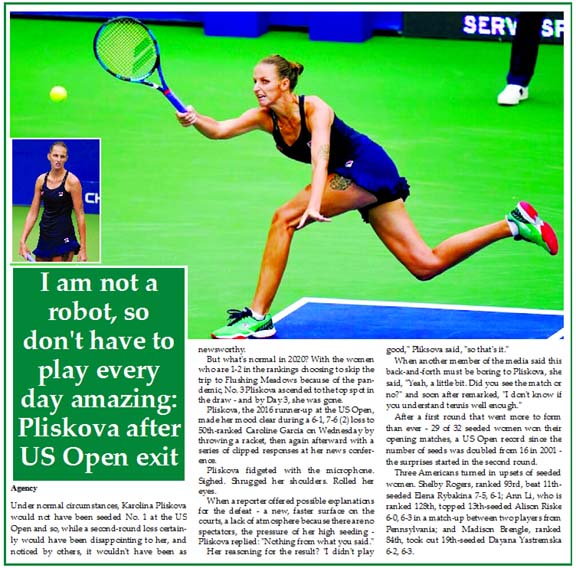
Agency :
Under normal circumstances, Karolina Pliskova would not have been seeded No. 1 at the US Open and so, while a second-round loss certainly would have been disappointing to her, and noticed by others, it wouldn’t have been as newsworthy.
But what’s normal in 2020? With the women who are 1-2 in the rankings choosing to skip the trip to Flushing Meadows because of the pandemic, No. 3 Pliskova ascended to the top spot in the draw – and by Day 3, she was gone.
Pliskova, the 2016 runner-up at the US Open, made her mood clear during a 6-1, 7-6 (2) loss to 50th-ranked Caroline Garcia on Wednesday by throwing a racket, then again afterward with a series of clipped responses at her news conference.
Pliskova fidgeted with the microphone. Sighed. Shrugged her shoulders. Rolled her eyes.
When a reporter offered possible explanations for the defeat – a new, faster surface on the courts, a lack of atmosphere because there are no spectators, the pressure of her high seeding – Pliskova replied: “Nothing from what you said.”
Her reasoning for the result? “I didn’t play good,” Pliksova said, “so that’s it.”
When another member of the media said this back-and-forth must be boring to Pliskova, she said, “Yeah, a little bit. Did you see the match or no?” and soon after remarked, “I don’t know if you understand tennis well enough.”
After a first round that went more to form than ever – 29 of 32 seeded women won their opening matches, a US Open record since the number of seeds was doubled from 16 in 2001 – the surprises started in the second round.
Three Americans turned in upsets of seeded women. Shelby Rogers, ranked 93rd, beat 11th-seeded Elena Rybakina 7-5, 6-1; Ann Li, who is ranked 128th, topped 13th-seeded Alison Riske 6-0, 6-3 in a match-up between two players from Pennsylvania; and Madison Brengle, ranked 84th, took out 19th-seeded Dayana Yastremska 6-2, 6-3.
Under normal circumstances, Karolina Pliskova would not have been seeded No. 1 at the US Open and so, while a second-round loss certainly would have been disappointing to her, and noticed by others, it wouldn’t have been as newsworthy.
But what’s normal in 2020? With the women who are 1-2 in the rankings choosing to skip the trip to Flushing Meadows because of the pandemic, No. 3 Pliskova ascended to the top spot in the draw – and by Day 3, she was gone.
Pliskova, the 2016 runner-up at the US Open, made her mood clear during a 6-1, 7-6 (2) loss to 50th-ranked Caroline Garcia on Wednesday by throwing a racket, then again afterward with a series of clipped responses at her news conference.
Pliskova fidgeted with the microphone. Sighed. Shrugged her shoulders. Rolled her eyes.
When a reporter offered possible explanations for the defeat – a new, faster surface on the courts, a lack of atmosphere because there are no spectators, the pressure of her high seeding – Pliskova replied: “Nothing from what you said.”
Her reasoning for the result? “I didn’t play good,” Pliksova said, “so that’s it.”
When another member of the media said this back-and-forth must be boring to Pliskova, she said, “Yeah, a little bit. Did you see the match or no?” and soon after remarked, “I don’t know if you understand tennis well enough.”
After a first round that went more to form than ever – 29 of 32 seeded women won their opening matches, a US Open record since the number of seeds was doubled from 16 in 2001 – the surprises started in the second round.
Three Americans turned in upsets of seeded women. Shelby Rogers, ranked 93rd, beat 11th-seeded Elena Rybakina 7-5, 6-1; Ann Li, who is ranked 128th, topped 13th-seeded Alison Riske 6-0, 6-3 in a match-up between two players from Pennsylvania; and Madison Brengle, ranked 84th, took out 19th-seeded Dayana Yastremska 6-2, 6-3.

